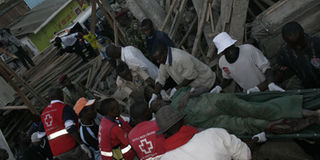Structural failure blamed for building collapse

A construction worker who only identified himself as Ouma being recued by Kenya Red Cross officials and members of the public from the rubbles after a building collapsed in Kiambu town on October 19, 2009. Photo/STEVE WAITHANJI
Engineers at the site where a building collapsed in Kiambu on Monday afternoon attribute the incident to a structural failure contributed partly by the excavation of a plot beside it.
At the same time, the Kenya Red Cross Cross said three people have died in the incident.
“We have confirmed three people died as we collected their bodies from the site,” Mr Titus Mung’ou, the society's communications manager, said
Officials from the Architectural Association of Kenya said on Tuesday the local authority's role in the construction of the five-storey building also needs to be looked into to determine whether procedure had been followed for the building to be put up.
Evans Goro, the secretary of the engineers' chapter within AAK, said an examination of the building's plan from the Municipal Council of Kiambu would assist the find out more details of the building's plan.
"What is clear for now is that there was a structural failure of the foundation, The plot next to it should not have been excavated below the foundation of the existing building without reinforcement," he said.
The building was on a hillside and started falling from the back, the side overlooking Riara River.
The officials said the developer on the neighbouring property also ought to have submitted plans to the local authority, who would also have recommended reinforcement of the neighbouring building before excavation is allowed.
The absence of a site sign board also complicated efforts by the AAK officials and journalists at the scene to trace the developer, engineers and architects at the site, intended for completion in February next year.
"We do not know where the technical people are to gather the information we need. There is no site office and site signboard to guide us to the professionals, if any, to give the history of the building," said Mr Goro.
Attempts to speak to the mayor and the town clerk of Kiambu municipality were futile as they were headed for the Kenyatta day celebrations at Ndumberi 3 kilometres away.
Construction at the site began in September last year and according to the foreman, Robert Makau, it was running behind schedule as it was meant to be complete and ready for occupation by this month.
AAK has been pushing for the fast tracking of the National Planning and Building Bill, whose enactment would establish a National Planning Authority that would take the role of approving building and construction in Kenya.
Benson Githinji, the secretary of the architect's chapter, said the haphazard development of buildings within the jurisdiction of the ministry of Nairobi Metropolitan Development needed to be addressed urgently.
"They should treat it as seriously as they would a major epidemic," said Mr Githinji.
The construction of a building involves the developer/owner, contractor, the local authorities for the necessary approvals and the professionals to give the technical input. A look at most collapsed buildings this year shows that often, it is the absence of professionals that leads to collapse, mostly due to structural issues.
Mr Mung'ou added that there are 17 people who have been recorded missing from relatives and friends but noted there could be double registration.
“We cannot confirm on the number because relatives and friends are bound to have registered their relatives twice as some are only giving one name. It has happened especially during the Nakumatt fire tragedy,” he said.
He further said that 18 people had been rescued where one was admitted at the Kenyatta national hospital.
“Seven have already been discharged while others are admitted at the Kiambu District hospital,” he added.
Speaking while addressing the media at the site he commended the efforts of the neighbours, Red Cross team and the different stakeholders on site including the disciplined forces.
The main challenge in such situations according to Mr Mung’ou is that many Kenyans are not trained in disaster preparedness.
He also noted that there should be sniffer dogs which would have helped in identifying where the people are and direct in the removal of the debris.
Mr Mung’ou said the main task was to trace, re-unite and manage the disaster. “We as Kenyans have a lesson to learn from the disasters that have rocked us and it is the high time we try our level best to avert them,” he added.




